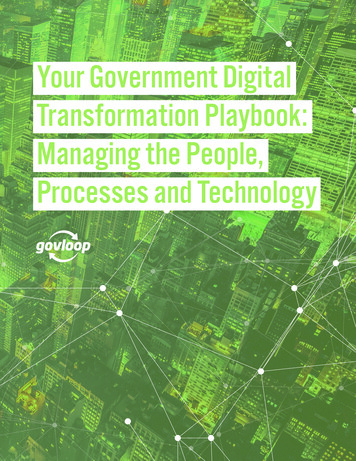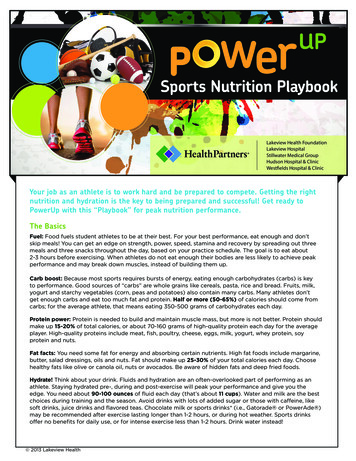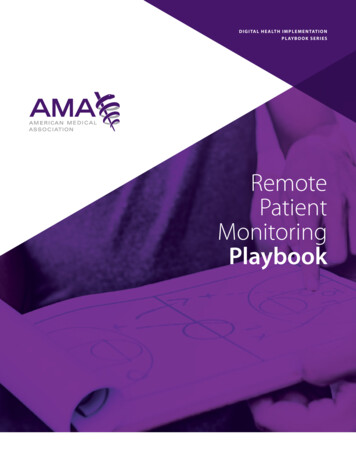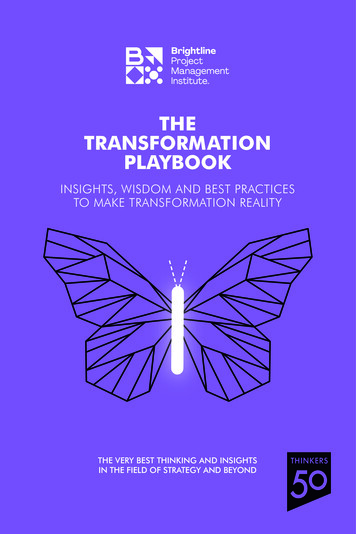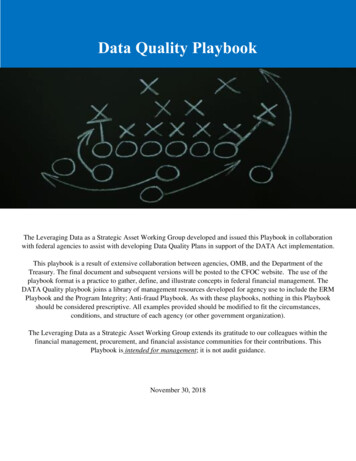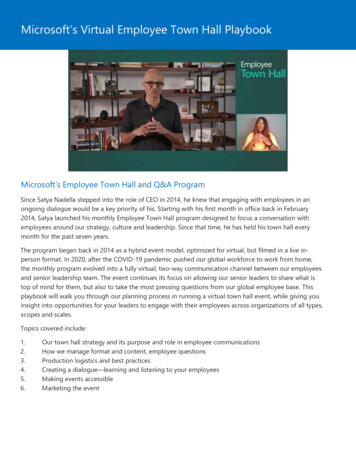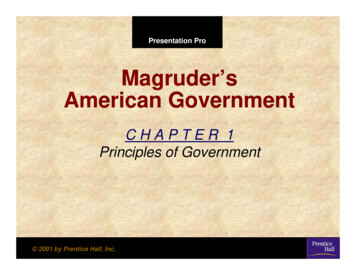
Transcription
Playbook: Government as a PlatformRichard PopeSenior Fellow, Government PlatformAsh Center for Democratic Governance and InnovationNovember 2019
Playbook: Government as a PlatformRichard PopeSenior Fellow, Government PlatformAsh Center for Democratic Governance and InnovationNovember 2019
playbook: Government as a Platformabout the authorRichard Pope (@richardjpope) was part of the founding team at the UK GovernmentDigital Service, working as a product manager for the first versions of GOV.UK, whichwent on to win the Design of the Year award in 2013, and co-authoring the Digital byDefault Service Standard, which all UK government digital services must meet. Heworked with policy and delivery teams across the UK government redesigning government services in policy areas as diverse as welfare, land registration, and employment.He was involved in the early days of the UK civic tech scene and worked at variousstart-ups as a technologist and designer.iii
playbook: Government as a Platformabout the ash centerThe Roy and Lila Ash Center for Democratic Governance and Innovation advancesexcellence and innovation in governance and public policy through research, education, and public discussion. The Ford Foundation is a founding donor of the Center.Three major programs support the Center’s mission: The Program on Democratic Governance, the Innovations in Government Program, and the Rajawali Foundation Institute for Asia. This research paper is one in a series published by the Ash Center forDemocratic Governance and Innovation at Harvard University’s John F. Kennedy Schoolof Government. The views expressed in the Ash Center Policy Briefs Series are thoseof the author(s) and do not necessarily reflect those of the John F. Kennedy School ofGovernment or of Harvard University. The papers in this series are intended to elicitfeedback and to encourage debate on important public policy challenges.This paper is copyrighted by the author(s). It cannot be reproduced without permission. Per the Ash Center’s Open Access Policy, this paper is available for downloadto the public free of charge at ash.harvard.edu.acknowledgementsThis playbook was written as part of a fellowship at the Harvard Kennedy School digitalHKS initiative.Thanks to the following people for their feedback, contributions and help:Adam Conners, Amy Hupe, Andrew Greenway, Ben Mcguire, Ben Welby, DanielAbadie, David Eaves, James Darling, Mairi Robertson, Matt Sheret, Nicola Barker, PeteHerlihy, Pia Andrews, Sam Smith, Sam Smith, Sarah John, Steve Marshall, Trilly Chatterjee, Vanessa Rhinesmith, Will Myddleton, Zara Rahman and many others who tookthe time for a quick chat or suggested links to include.This paper is copyrighted by the author(s). It cannot be reproduced or reused without permission.iv
playbook: Government as a PlatformcontentsIntroduction1Definitions and Terminology5Users7Identifying Platforms11Designing for Self-Service16Data Infrastructure, APIs and Open Standards19Working across Silos22Reuse25Funding and Operations27Adoption30Designing Services on Top of Platforms32Identity, Trust and Consent40Explaining Government as a Platform50
playbook: Government as a PlatformintroductionIf you walked into a government office, anywhere on the planet in the 20th Century, youwould probably have found three things: a records department managing paper files,index cards or microfiche; administrative staff processing and validating information,either in person over-the-counter or in back-offices, executing the rules set out in different government policies; finally, you’d find forms. Lots and lots of forms.On the outside of the building, you’d find a sign that contains a word like “driving,” “passport” or “tax.” That’s because most government departments were, andstill are, thematically organized, with responsibility for everything from the top to thebottom of an area of government.As governments began to put more of their services online, this was the worldthey digitized. So, today, if you were to look at the technology stack of a typical government agency—let’s say a motoring agency with responsibility for issuing driving andvehicle licences—you’d see something like this: A series of online transactions—apply for a driving licence, renew a licence,report a change of address—that would more or less map directly to the paperforms they replaced. There would be admin systems for things like managing payments or validating addresses—things that humans used to do manually, but these days aresemi-automated. The business rules once written out in a policy documenthave been turned into code. Finally, there would be a series of databases—for our hypothetical drivingagency, that might be a database of drivers and their cars, and some sort ofcase-management system for keeping track of applications. These databaseshave (mostly) replaced the records departments and paper files that once tookover whole floors of government buildings.This is a pattern that is replicated across government—the pattern repeated in different agencies and at different layers of government. So, if you were to look at land registration, social security, or tax departments, in central government or local government,you’d probably see a similar pattern.1
playbook: Government as a PlatformDigitizing a World of PaperYou might be asking, why is this a problem? Surely making things work more efficientlyis a good thing? There are several reasons why not.When it comes to using data from one part of government in another part ofgovernment—maybe someone wants to be able to prove they own a car to the taxoffice—the prevailing practice is what is referred to euphemistically as “data sharing.”It’s referred to as “sharing,” but it’s actually closer to copying-and-pasting. Records indatabases are not like pieces of paper in a file, so “data sharing” often means multiplecopies of the same data end up scattered across government, which then has implications for accuracy, security and privacy.As well as duplication of data there is duplication of effort too. Remember, ourhypothetical driving agency? It probably has a payment processing system so peoplecould pay for their driving licences. But other agencies also need to process payments,so public money ends up being spent on the multiple systems, all doing the samething. The same is true for other commons tasks too, things like messaging or printing.Thirdly (and most important), is the impact on the design of services that thepublic have to use. In computer science, there’s an adage called “Conway’s law.”1 It isnamed after computer programmer Melvin Conway, and it says that:organizations which design systems . . . are constrained to produce designswhich are copies of the communication structures of these organizations.2Government is this idea writ large—with services designed around the organizationalstructure of government rather than the needs of people. This means a family lookingto move house, someone recovering from an illness or someone looking to start acompany, will have to deal separately with many government agencies. Some peoplefall through the gaps, and you have to ask: what that does to those people’s trust inthe state?It also leads to a monopoly of provision—a one-to-one mapping between department and services, which often means it’s impossible for other parts of government,122Melvin E. Conway, “How do Committees Invent?,” Datamation, 14, no. 5 (1968):28–31.Conway, “How do Committees Invent?,” 28–311.
playbook: Government as a Platformor companies and charities, to build complementary services. That’s because the dataand the business logic are locked away inside these organizations.Platforms Are Changing GovernmentsLooking around the world, we can see a different approach emerging. One ofcross-government platforms that are beginning to break down organizational silos,save money and change the types of services that can be delivered to the public.For example, in the United States, the US Veterans Administration has begun tobuild its services around APIs. These allow veterans charities and other organizations(not just government) to build public-facing services.3 This work is part of a federateddata effort across central and state governments to build APIs and exchange data toagreed formats.4In India, the Aadhaar identity platform has started to link together services fromacross different parts of government for a billion people. In the process, it has created a national debate about privacy and digital rights.5 Aadhaar is part of IndiaStack,which the government refers to as “a set of APIs that allows governments, businesses,startups and developers to utilize an unique digital infrastructure to solve India’s hardproblems toward presence-less, paperless, and cashless service delivery.”6Estonia is starting to design new services around “life events,” like having a child,that transcend the boundaries of government agencies. They can do this because ofcommon cross-government data infrastructure they have developed over the pastdecade.7 And because neighbouring countries have adopted that infrastructure, itholds out the promise of simpler trade, and citizens accessing services across borders.83US Department of Veterans Affairs, “Put VA Data to Work,” https://developer.va.gov. Retrieved 5th June 2019.4Julia Lindpaintner, “The US Data Federation wants to make it easier to collect, combine, and exchange dataacross government,” 5th March 2019, ion/.5UIDAI, Addhaar Dashboard, https://uidai.gov.in/aadhaar dashboard/index.php. Retrieved 5th June 2019.6“What is India Stack?,” https://indiastack.org/about/. Retrieved 5th June 2019.7Sam Trendall, “We have only scratched the surface’—Estonia’s CIO on what’s next for the world’s most celebrated digital nation,” PublicTechnology.net, 18th February 2019, cio-what’s-next-world’s-most.8Finnish Patent “Estonian Ministry of Justice: The Ministry of Justice entered into an agreement with Finland forthe exchange of business register data,” https://www.prh.fi/en/uutislistaus/2019/P 17654.html.3
playbook: Government as a PlatformIn the UK, Italy, and Argentina shared components solve common problems forthe whole of government. For example: sending a text message, hosting a web application or taking a payment. These components are run centrally, rather than by individualagencies, helping civil servants to deliver new services faster and creating more consistent experiences for citizens.9 10 11Government as a PlatformTaken together, what we are seeing is the realization of the world sketched out by TimO’Reilly in his 2011 article “Government as a Platform,” where he posed the question:what if government was organized more like an operating system?12Government as a Platform holds out the promise of radically better services for thepublic. And to do so in a way that makes it simpler and faster for both civil servants andpoliticians, the private sector and non-profits, to meet people’s needs. A world of government reorganized around shared components, APIs, standards and canonical datasets.Who This Playbook Is ForAround the world, digital service units along the lines of the UK’s Government Digital Service, Italy’s Team per la Trasformazione Digitale, 18F, and the Canadian DigitalService are springing up. Teams like these have brought modern digital ways of working into the heart of government, adopting agile software development, user centereddesign, and the use of cloud hosting and open-source technology.Along with new practices, these organizations have brought new professionsinto government:13 product managers, software engineers, user researchers, servicedesigners, data scientists and chief digital officers. These people are the intendedaudience of this playbook: practitioners looking for approaches to implementing platforms in government.9HM Government, “Design and build government services,” . Retrieved 30th April 2019.10Team Digitale, “Projects,” https://teamdigitale.governo.it/en/projects.htm. Retrieved 30th April 2019.11Mike Bracken, “Argentina just made driving licences digital,” Public Digital Blog, 12th February 2019, ade-driving-licences-digital/.12Tim O’Reilly, “Government as a Platform,” Innovations, 6, no. 1 (2011):13–40.13Or in some instances re-introduced capabilities long-since outsourced.4
playbook: Government as a PlatformAs such, there is some level of minimum capability that an organization needsbefore it starts trying to implement many of the examples listed in this playbook. If youare working in an organization that is just starting on its digital transformation journey,then probably the best thing to do is focus on building an effective user centred designcapability first.Even for more digitally mature organizations, attempting to do everything listedhere at once is probably a bad idea. Every organization will have strategic decisions tomake about where to start. Please view this as a starting point rather than a detailedjourney map.Wherever possible, it includes footnotes and links to further reading and quotesfrom practitioners.definitions and terminologyIn any multidisciplinary field, definitions and terminology have a tendency to createtrip-hazards. This is definitely the case in “platform land.” A service may mean something different to a service designer than it does to a software engineer; for some aplatform carries with it assumptions about multi-sided market places, for others, it’sjust a component to be built upon.In this playbook, the following definitions are used:ServicesPublic-facing services allow citizens or their representatives to achieve a desired outcome. With appropriate governance, services can be provided by any layer of government, and by commercial or third sector organizations. Services are the things that arebuilt on top of platforms.Digital proofsThe term digital proofs is used to cover the various different ways that someone canprove a fact (for example that they are entitled to a free prescription). This includes5
playbook: Government as a Platformcryptographically signed data, and one-use codes or barcodes that can be used toverify a fact online.Government as a PlatformThe term “Government as a Platform’ is used to refer to the whole ecosystem of sharedAPIs and components, open-standards and canonical datasets, as well as the servicesbuilt on top of them and governance processes that (hopefully) keep the wider systemsafe and accountable.Shared APIsShared APIs expose the business logic of government, for example, calculating a benefit payment or checking the status of an application. They are referred to as “shared”to indicate that they are available for use beyond the agency that developed them.PlatformsThe term platform is used in the generic sense to refer to any shared API, shared component, trust and identity system, or register.RegistersRegisters are canonical datasets that are used and trusted across government andbeyond. For example, a single list of postal addresses or a single list of registered companies. They expose the data via APIs to agreed open-standards and have appropriategovernance and ownership in place.Shared componentsShared components solve common problems for the whole of government (and potentially beyond). For example: sending a text message, hosting a web application, takinga payment or signing a document.6
playbook: Government as a PlatformTrust and identity systemsTrust and identity systems ensure that data is only accessed for appropriate purposes,and that use is understandable and trusted by citizens or their representatives. For example: authentication, trust verification, data exchange and key management systems.usersIt is one of the tenets of user centred design that services should be designed aroundthe needs of users. Platforms are building blocks, used to create many differentpublic-facing services, so the primary users of a platform tend not to be the publicthemselves (the end-users of services), but rather the people and organizations whouse them to create services for the public. A platform might have users across differenttiers of government and non-government organizations.1. Think of platforms as part of many servicesIf successful, a platform will be part of many public facing services, for example, an APIfor validating and geocoding addresses might be used in services that let people taxtheir car, find a hospital, or apply for benefits. As such, a team developing a platformmay have only a limited relationship with the end-users of those services, and the public will experience the platform as part of a wider service, not in isolation.This “one-to-many” nature of platforms also means that any changes you make tothem will affect many different types of user and many different services. This comeswith a responsibility to understand the likely impacts of any changes you make andto work in an open way. The teams using your platform need to be able to anticipatechanges early and ensure they work for users of their service.Conduct joint user research with teams using your platform, so that you canunderstand how your platform manifests itself in different services. Work in the openand maintain good communications with your users, so you understand how they areusing the platform and ensure they understand any upcoming changes.7
playbook: Government as a Platform2. Understand who your users areBecause shared components, APIs, registers and identity systems are building blocksof public-facing services, it’s important to understand the users of a platform are oftennot the public (at least not directly). Designing a good platform will require an understanding of their needs, but first you need to identify who they might be. Some important user types to understand include: Developers wanting to integrate with your platforms quickly and simply. Designers of a public-facing service who may need to understand how yourplatform will fit into the broader design of a service, or include it in prototypesthey are testing. Procurement managers who need to understand any contractual or financialarrangements. Administrators who need to manage the use of the platform, view usagereports or changing their settings. The team developing the platform who will need to understand how otherusers are using the platform. The general public (and their proxies, such as journalists, charities or electedrepresentatives) who want to understand how you are spending their moneyand managing public data. Politicians or senior officials who might have statutory responsibility for yourplatform or the services using it.You should identify people and organizations who might use your platform, and understand their needs (remembering that they may not work in government at all and maywork in non-technical roles such as procurement).3. Understand where your users areLooking around the world, government platforms tend to have users in one of threegroups:1. Limited to a single tier of government—for example used by a single state in afederal system, or only by central government.8
playbook: Government as a Platform2. Government-wide—used across central, municipal and regional government.3. Society-wide—for example, in addition to use in government, a platform is alsoused in banking, or by third sector organizations and commercial companies.To take one example, we can see this pattern if we look at the identity and authenticationplatforms from the US, UK and India. Login.gov provides a way to add single-sign-on todigital services, but is limited to US federal agencies.14 GOV.UK Verify provides a similarservice (albeit with additional levels of identity verification and multiple identity providers) for central government in the UK, but there have also been trials to use it in localgovernment too.15, 16 While in India, the Aadhaar identity platform is used well beyondgovernment services for people to open bank accounts (and not without controversy). 17It is important not to take away from this that “the broader the usage the betterthe platform.” There may be very good reasons for focusing on a subset of institutionsearly on. There may also be circumstances where a single society-wide platform hastoo many significant risks associated with it. (Identity is indeed one area where a single, centralized system might be undesirable!) The key thing to understand is that thisis a strategic decision that can be made, and one that can change over time. Who yourusers are will change too.14login.gov describes it’s aim as to make “federal benefits, services and applications easier and more secure.”US General Services Administration, “login.gov,” https://login.gov. Retrieved 5th June 2019.15Joanne Southern, “Guest post: working with GDS on transforming local services,” GOV.UK Verify Blog,22nd March 2017, ervices/.16Angelica Mari, “London council trials Verify-based digital ID scheme for vulnerable citizens,” Computer Weekly,20th May 2019, or-vulnerable-citizens.17“Banks can use Aadhaar for KYC with customer’s consent: RBI,” Economic Times, 29th may 2019, s.9
playbook: Government as a PlatformExample: Identifying users of Government as a Platform in the UKIn the UK, much of the early work of the Government Digital Service had been focusedon projects with significant public-facing elements. As the organization began to focusmore explicitly on platforms, it had to change how it thought about users:Many of us joined the Government Digital Service to work directly on things whichmatter to users. We realized that, organizationally, our job had shifted to meetingthe needs of other civil servants, so that they can meet the needs of their usersand, as a consequence of that, public services improve and the quality of people’s experience of the state is transformed.Citizens are not the only valid users—even GOV.UK itself has a huge numberof civil servant users who are using it as a publishing tool.We needed to start thinking about our users as being service teams aroundgovernment. Shifting from thinking about making services for citizens to makingproducts for service teams was a tough shift for GDS.To identify the needs of our users, we did 150 interviews with service teamsacross government. We identified those teams from service assessments, the GOV.UK performance platform and also the 4,000 PDF forms that are hosted on GOV.UK. We asked them things like: Tell us about your users? Tell us about the needsyou are meeting? Tell us about the needs you can’t meet but would love to meet?—Ben Welby & Will Myddelton, Government as a Platform programme 2013,2018 (UK)10
playbook: Government as a Platformidentifying platformsPlatforms solve problems once, meeting the common needs of users, rather thanaddressing the same problem multiple times, and in slightly different ways. Thoseusers might be elsewhere in government, in a different tier of government or outsidegovernment altogether (for example, a private company or charity).Your organization will need to prioritize three things to help it identify where thereis a genuine opportunity to do this, and where the opportunity is purely superficial:1. The capability to identify common needs and duplication.2. Creating clear routes for “point solutions” from specific products to develop intomore general platforms.3. An understanding of what the right level of abstraction is for a platform (good platforms do one thing well).1. Identify common needs and duplicationChances are you are already aware of lots of duplication. It might be multiple servicesall using different payment systems or address lookups. It might be developers fromdifferent teams creating their own login system or hosting setup. In fact, this seems tobe the normal state of most organizations developing digital services.However, just hoping that shared APIs, components and registers will emergeorganically from this is unlikely to lead to results. For example, no shared components,APIs or registers emerged from the UK Government Digital Service’s Exemplar programme (which saw teams setup across government to redesign digital services).11
playbook: Government as a PlatformThere is no single approach to doing this, but approaches you might like to consider include: Conducting interviews and surveys to understand where common needs mightexist.18 Using Wardley Mapping to identify duplication.19 Use governance processes, such as service standard assessments, to collectdata about common needs.20 Review legislation and guidance to identify where one service might benefitfrom API access to another. Review code repositories to identify teams working on the same problem. Create a service map or user-journey map and use it to identify commonneeds.21 Create a map of the data ecosystem and use it to identify common needs, anddatasets that can be adapted into common registers.22Regardless of approach, all these activities take some time and effort, and will be competing against other priorities. So, make it clear where responsibility to spot commonneeds and duplication across teams lies.18In the UK, the Government Digital Service conducted 150 interviews with teams across government with the aimof understanding their common needs. It led GDS to understand they should prioritize a form building platformover one that, for example, accepted payments from the public, because more services needed it. RichardPope, “Interview with Will Myddelton—UK Government as a Platform programme,” 29th October 2018, .19Wardley Mapping is an approach to visualising the components required to deliver a service. Simon Wardley,“An introduction to Wardley (Value Chain) Mapping,” Bits or Pieces? (blog), 2nd February 2015, on-to-wardley-value-chain.html.20The Government Digital Service identified potential teams to work with to help identify platforms from “serviceassessments,” which are a step in the governance process for all new digital services. Richard Pope, “Interviewwith Will Myddelton—UK Government as a Platform programme,” 29th October 2018, .21The UK Ministry of Justice created a visual map of all the activities that take place in the justice system,agnostic from the organizations who run them. Mike Bracken, “Mapping new ideas for the digital justice system,” Government Digital Service Blog, 18th August 2015, as-for-the-digital-justice-system-2/.22The Open Data Institute have developed a process for documenting and mapping data ecosystems. Open DataInstitute, “Mapping data ecosystems,” 23rd March 2018, /.12
playbook: Government as a Platform2. Provide a path from products to platformsA less top-down approach than identifying common needs and duplication is to ensurethere are clear routes for “point solutions” from individual products to develop intoshared platforms. A point solution is something that has been developed as part of asingle service, that might be useful as a more general platform for multiple services.For example, the authentication platform, Login.gov, started life as a larger project called MyUSA, which aimed to provide a single account and to do list for interactingwith government. The authentication part of the project was developed into login.govby 18F and the United States Digital Service.23Another example is the letter printing feature of the GOV.UK Notify messagingplatform. It makes use of the spare printing capacity at the UK driving licence agency’ssecure printing facility that was created when printed “tax discs” were abolished.24This approach is similar to that taken by many teams at commercial platform companies, where problems are first solved within product teams, but then supported withstaff and funding to turn them into more general solutions.Within Google, setting up a new team is often off the back of what is alreadyhappening organically. Google tends to create a set of core, high-level values whileallowing space to innovate. Things that are mandated are really high-level, rather thanday-to-day—everything rolls-up to a higher objective.25For commercial services, the “route to market” is potentially clearer—for example, an Amazon platform can ultimately appear in the AWS dashboard alongside thecompany’s other offerings where developers can use (and pay) for it. For the approachto be a success, teams working in government will need to be supported to generalizetheir point-solutions into platforms.2318F, “18F/myusa,” https://github.com/18F/myusa. Retrieved 26th June 2019.24@yahoopete (Pete Herlihy), “One of the coolest things about this, is that we made a deal with the DVLA to usetheir secure, modern on-site print facilities for our letter fulfilment. Having stopped printing tax discs etc a fewyears back, they had capacity. And we could maximise the savings to taxpayers.” 16th April 2019,https://twitter.com/yahoo pete/status/1118245112482598912?s 12.25Interview, Dr. Adam Connors, Senior Google Engineering Manager.13
playbook: Government as a Platform3. Identify real-world platformsPlatforms normally get tal
thing. The same is true for other commons tasks too, things like messaging or printing. Thirdly (and most important), is the impact on the design of services that the public have to use. In computer science, there's an adage called "Conway's law." 1 It is named after computer programmer Melvin Conway, and it says that:
